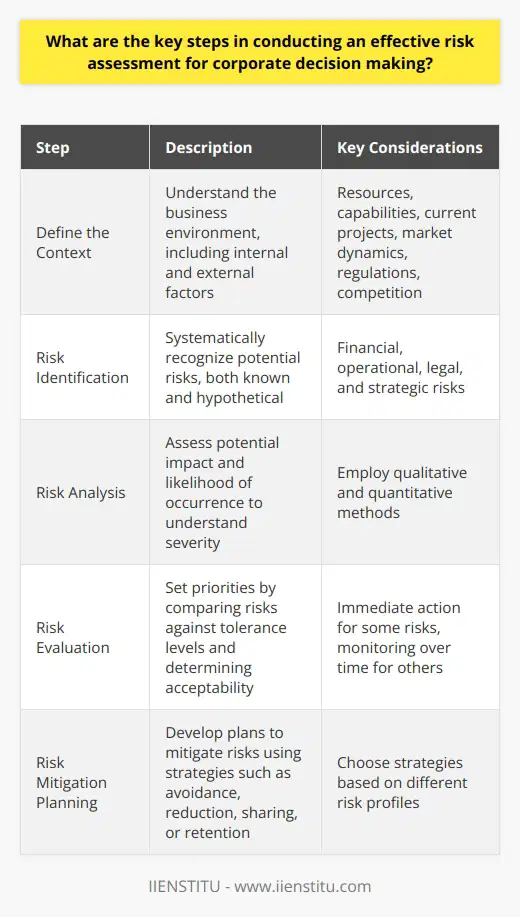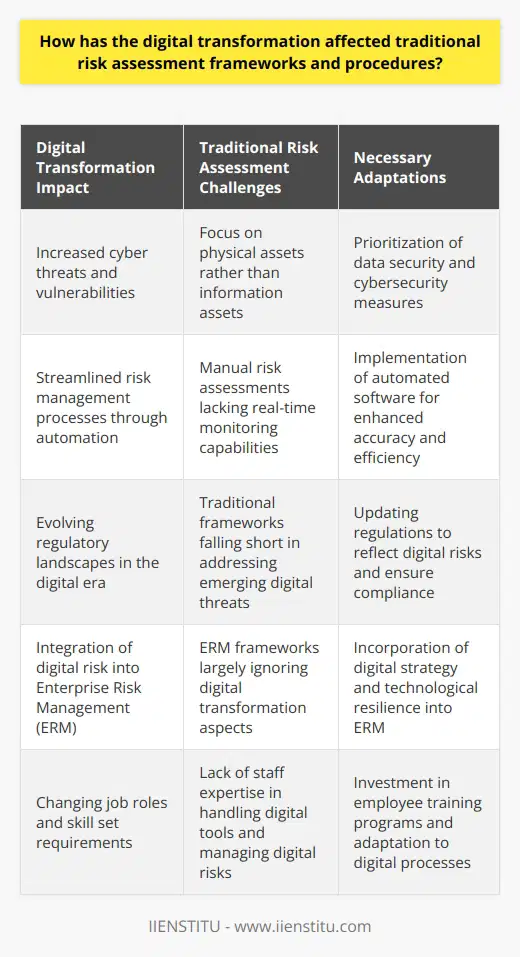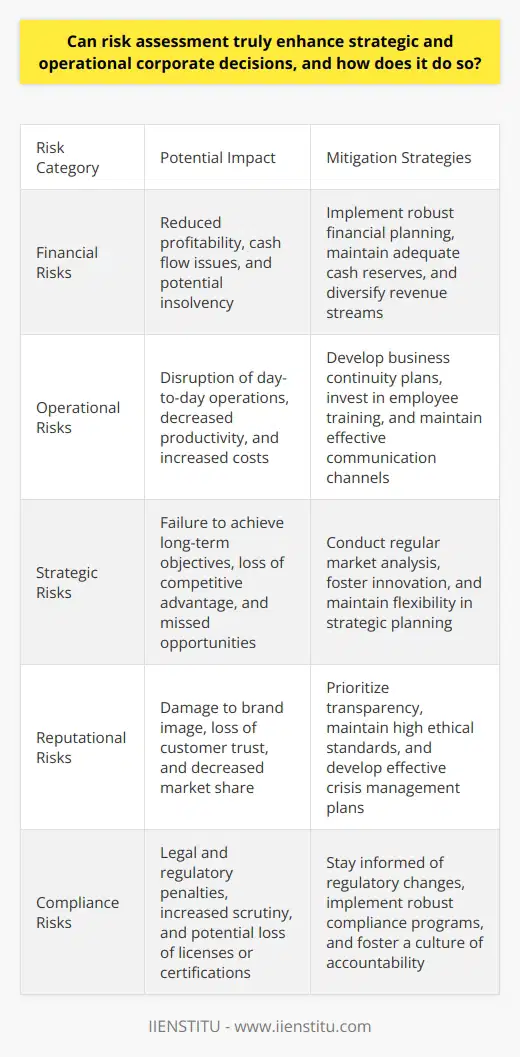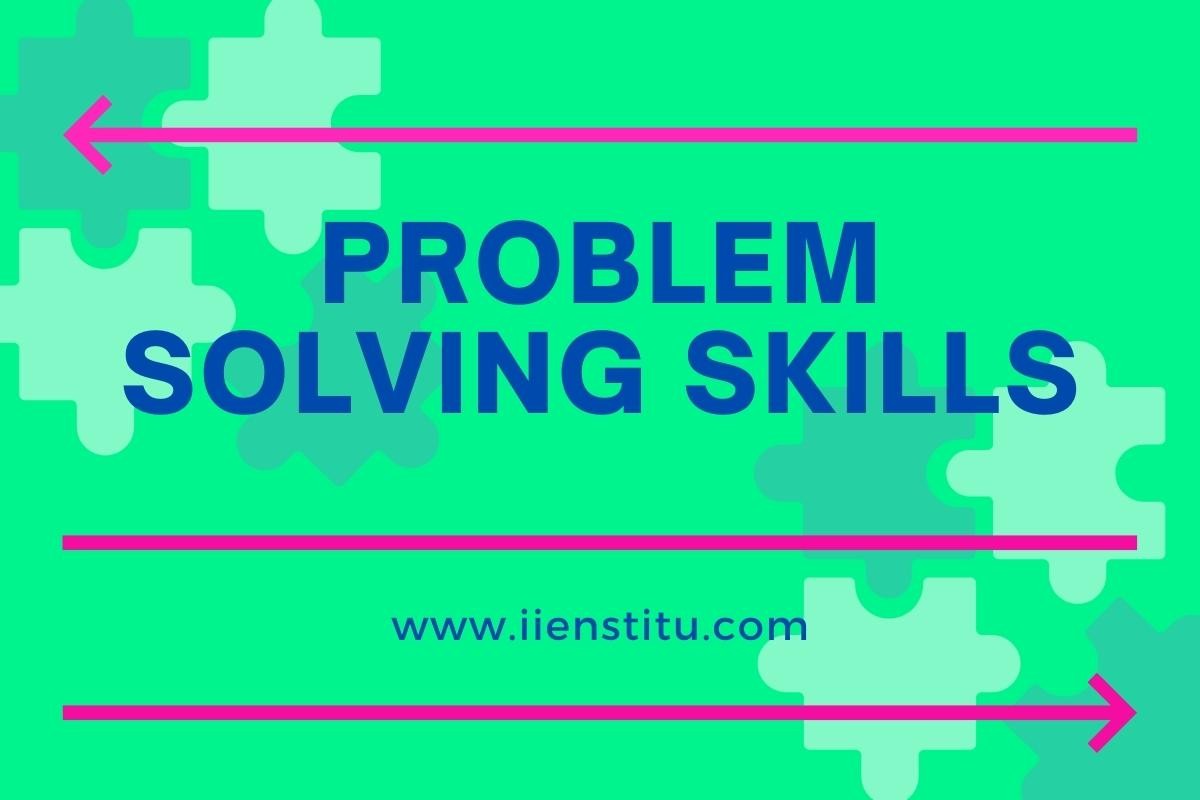
Risk assessment is a critical stepping stone in every strategic and operational decision-making process within a corporation. It involves the systematic identification and evaluation of potential risks that could negatively impact an organization's assets and earning capacity. Risk assessment is fundamentally a problem-solving process, aimed at identifying, categorizing, and prioritizing potential risks. With the evolution of risk management techniques, several online certificate courses, including problem-solving skills courses, are becoming increasingly relevant in providing the necessary knowledge and skills for conducting comprehensive and effective risk assessments.
I. Introduction
A. Definition of risk assessment
Risk assessment is the disciplined approach of identifying, analyzing, evaluating, and prioritizing uncertain events that, if not addressed, could impact the objectivity of an organization's goals, objectives, and mission.
It is a systematic way of understanding and estimating the potential risks and the severity of their impact. The result of a risk assessment process is usually documented and used to inform decision-making and contingency planning.
B. Importance and purpose of risk assessment
The importance of a risk assessment cannot be overstated. It brings clarity to the uncertainties that could endanger an organization’s objective—be it strategic, operation, financial, or compliance. The primary purpose of carrying out a risk assessment is to provide decision-makers with a clear understanding of potential risks, allowing them to make informed decisions and judiciously deploy resources.
This step is quintessential for companies to understand their vulnerabilities and develop measures to mitigate their exposure to risk, thus ensuring sustainable operations.
II. Different Types of Risk Assessment
A. Qualitative Risk Assessment
What is Problem Solving? How to Do It? Step-by-Step Techniques
Quality Tools: Essential Techniques for Effective Decision-Making
Issue Tree Analysis: Breaking Down Complexities for Simplified Solutions
1. Definition and description
Qualitative risk assessment is a risk evaluation method that uses descriptive and subjective measures of risk rather than strict numerical metrics or ratings. It focuses on identifying the nature of a potential risk, its possible impact, and means to control it.
2. Use of qualitative risk assessment
Qualitative risk assessment is commonly used when there's no readily available or precise data about a specific risk. It relies heavily on the knowledge, experience, and judgment of the team members carrying out the analysis. It's often employed in the early stages of risk management, where the aim is to develop a general understanding of the potential risks.
3. Examples of qualitative risk assessment
For example, a company developing a new product might conduct a qualitative risk assessment to understand the various risks associated with a product launch, ranging from customer acceptance, market competition, to production and supply chain challenges. Each risk is then assessed based on expert opinion and categorized according to its potential impact and likelihood, providing a risk matrix that helps prioritize actions.
B. Quantitative Risk Assessment
1. Definition and description
Unlike its qualitative counterpart, a quantitative risk assessment employs numerical values and data to analyze and evaluate risks.
2. Situations where quantitative risk assessment is applied
It is favored when precise risk estimates are required, and it often forms an integral part of sophisticated risk management systems. It provides a more definitive and objective measure of risk and is typically applied in situations where the associated risk can be quantified in financial terms or by using statistical, mathematical, or computational models.
3. Examples of quantitative risk assessment
An example can be seen in insurance companies, using quantitative risk assessment to calculate the potential payout due to accidents or natural disasters. Another classic example is in investments, where quantitative risk assessment is used to explain and predict changes in portfolio value due to market fluctuations.
C. Comparative introduction of qualitative and quantitative risk assessment
Both qualitative and quantitative risk assessments have their merits in different situations. While qualitative assessments focus on identifying and setting priorities, quantitative assessments provide definitive results and value-driven insights. The choice between the two often depends on the available resources, data, and objective of the risk management process.
Frequently Asked Questions
What are the key steps in conducting an effective risk assessment for corporate decision making?
Understanding Risk Assessment
Risk assessment lies at the core of corporate decision-making. It requires a robust approach. Identifying risk forms the groundwork. It precedes mitigation strategies. Accurate assessments improve strategic decisions.
Step 1: Define the Context
Setting the context is critical. Aim to understand the business environment. Consider both internal and external factors. Internal factors include resources, capabilities, and current projects. External factors encompass market dynamics, regulations, and competition.
Step 2: Risk Identification
Recognize potential risks systematically. Begin by considering known risks. Then move to hypothetical scenarios. Think broadly across categories. Financial, operational, legal, and strategic risks matter.
Step 3: Risk Analysis
Once identified, analyze risks carefully. Assess potential impact. Consider likelihood of occurrence. The goal is understanding severity. This step often employs qualitative and quantitative methods.
Step 4: Risk Evaluation
Setting priorities comes next. Compare risks against tolerance levels. Determine acceptability. Some risks require immediate action. Others can be monitored over time.
Step 5: Risk Mitigation Planning
Develop plans to mitigate risks. Consider multiple strategies. Avoidance, reduction, sharing, or retention may apply. Each option suits different risk profiles.
Step 6: Implementation
Action the mitigation plans. Allocate resources efficiently. Responsibilities must be clear. Ensure that communication is effective.
Step 7: Monitoring and Review
Risk environments are dynamic. Continuous monitoring is essential. Assess the effectiveness of actions. Adjust strategies as necessary.
Step 8: Communication and Consultation
Engage with stakeholders throughout. Keep them informed. Their insights can refine assessments. Transparency supports decision-making.
Incorporating these steps ensures a thorough risk assessment. Decisions based on such assessments stand on firmer ground. The goal is a resilient, proactive organization.

How has the digital transformation affected traditional risk assessment frameworks and procedures?
Digital Transformation's Impact on Risk Assessment
Digital transformation reshapes industries globally. It revolutionizes how organizations operate. Traditional risk assessment frameworks now require updating. Current models never anticipated such rapid digital integration.
Assessing Technological Risks
Technological advancements introduce new vulnerabilities. Cyber threats now top the risk charts. Traditionally, physical assets demanded attention. Now, information assets pose greater concerns. Risk assessments focus more on data security. They prioritize cybersecurity measures.
- Cyber risk identification
- Data breach prevention
- Information security protocols
Digital tools also streamline risk management processes. Automated software replaces manual risk assessments. This enables real-time risk monitoring. It enhances the accuracy of threat detection.
Regulatory Challenges
Regulatory landscapes are changing. They must keep pace with technology. Traditional frameworks often fall short here. Digital transformation demands updated regulations. These should reflect emerging digital threats.
- Updated compliance requirements
- Stricter data protection laws
- International regulatory coordination
Compliance becomes more complex. Risk assessors must understand global regulations. They also need knowledge of local laws.
Impact on Enterprise Risk Management (ERM)
ERM frameworks are evolving. They integrate digital risk into their core. Traditional ERM largely ignored digital transformation. Current models include technology risk as a component.
- Digital strategy incorporation
- Emphasis on technological resilience
- Fundamental role in strategic planning
Digital transformation changes risk profiles. It adds new layers to risk assessments. Strategists must consider these in ERM.
The Human Factor
Digital transformation affects manpower as well. Staff need new skills to handle digital tools. This demands significant investment in training.
- Employee training programs
- New skill set requirements
- Adaptation to digital processes
Job roles are also changing. They now include digital risk management elements. Employees must understand cyber threats.
Agility in Assessment
Agility becomes crucial in risk assessment. Traditional methods were often static. They lacked flexibility. Digital markets move quickly. Risk assessment procedures must adapt.
- Quick response mechanisms
- Dynamic risk evaluation processes
- Continuous assessment strategies
Conclusion
Digital transformation redefines risk management. Traditional frameworks undergo continuous revision. Assessments have become more intricate. They demand extensive knowledge of digital processes. Businesses must adapt risk assessment methods. They ensure resilience in a digital age.

Can risk assessment truly enhance strategic and operational corporate decisions, and how does it do so?
Risk assessment stands as a critical tool. It forms the backbone of effective decision-making in businesses. Corporations encounter risks in numerous forms. These extend from financial, operational, to strategic challenges. A well-structured risk assessment process can thus enhance decision-making at both strategic and operational levels.
Understanding Risk Assessment
At its core, risk assessment involves identifying, analyzing, and evaluating risks. It is about understanding potential threats to a corporation's objectives. The practice prioritizes risks based on their potential impact and likelihood.
Enhancing Strategic Decisions
Strategic decisions shape the future of a company. They require a long-term outlook and are often complex in nature. Risk assessment provides a foundation for informed strategic choices. It does so by identifying potential hazards to long-term goals. This enables leaders to develop strategies that are robust and resilient.
Operational Decisions
Similarly, risk assessment influences day-to-day management. It does this by identifying what could go wrong at an operational level. It allows for the implementation of proactive measures. This minimizes disruptions in the company's operations. It ensures that resources can focus on value-adding activities.
Risk Assessment and Decision-Making
Relevant risk assessment equips decision-makers with critical insights. It provides a clearer picture of the risk landscape. This information guides both strategic plans and operational tactics.
- Prioritization becomes easier
- Resource allocation improves
- Strategies become more adaptive
Frameworks and Methodologies
A variety of frameworks and methodologies support risk assessment. These ensure that the process is systematic and comprehensive.
- It integrates qualitative and quantitative measures
- It highlights interdependencies among risks
- It uncovers insights through scenario planning
Effective Implementation
Effective risk assessment requires commitment and expertise. Stakeholders need to understand its importance. Management must support its integration into corporate decision-making processes.
- Communication is key to its success
- Training enhances its effectiveness
- It fosters a risk-aware culture
Conclusion
Risk assessment does not only identify threats. It also reveals opportunities. It allows businesses to navigate uncertainty with confidence. It makes strategies more robust and operations more secure. Corporations thus benefit from decision-making processes that are informed, strategic, and practical.



